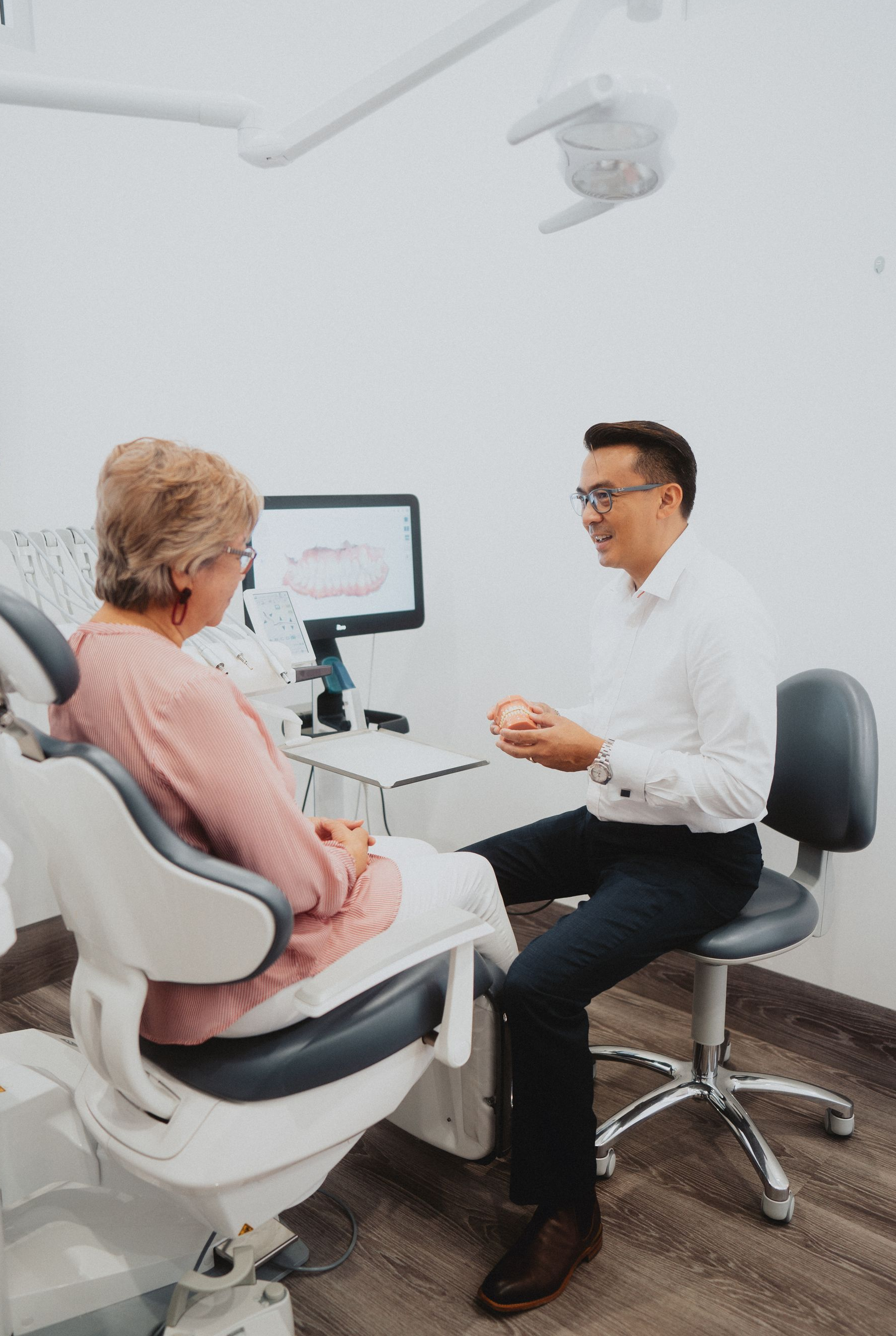COSMETIC DENTISTRY CENTRAL COAST
Explore Cosmetic dentistry
At New Leaf Dentists, we provide cosmetic dentistry services for our patients in Erina, Gosford and surrounding areas on the Central Coast, including teeth whitening, veneers, and teeth straightening, to complete smile makeovers. Whether you want to enhance brightness, improve symmetry, adjust alignment, or smile design, there are options to suit different goals and treatment needs. Consultations are available to discuss treatment suitability, timelines, and the different techniques involved.
To learn more about what we can do for you, or to schedule a consultation, call
02 4367 6222 today.
What is Cosmetic Dentistry?
Aesthetic dentistry, often referred to as “cosmetic dentistry”, is the term used to describe treatments that change the way your teeth look. You may want to change the colour, the shape, the position of your teeth or replace a missing tooth. You may think of it as changing the way you look when you smile or even when you are trying to keep a straight face.
In cosmetic dentistry, there is far more involved than simply changing the appearance of your teeth. Embarking on a cosmetic dental journey would firstly start with your dental fitness. It’s important to have a dentist conduct a full examination of your mouth and assess the condition of your gums, your teeth, and treat any oral health issues that may arise from that examination. Your health comes first! Improving and maintaining good oral health is key to a successful cosmetic dentistry result.
While a cosmetic procedure like teeth whitening is included in aesthetic dentistry, the field is mostly concerned with orthodontic treatment which involves teeth straightening (thus improving your bite and functionality of your teeth and jaw), and restorative dentistry, which involves the insertion of crowns, veneers and dental implants.
Here at New Leaf Dentists, we believe in improving your overall oral health while also achieving the smile that you’ve always dreamed of. Our dentists will spend time with you to talk about where you are right now, any previous treatments you’ve had and where you got to, your range of options, the pros and cons, an “expectation vs reality” discussion, and work out a plan that suits your time, your budget, your lifestyle, and your commitment to partner with us to ensure that your smile design will have long term results.
Teeth Whitening
As the name suggests, this treatment is all about lightening stained or discoloured teeth.
While you can buy over-the-counter, use-at-home toothpaste and strips, your dentist is best qualified to determine if you need teeth whitening. They can diagnose the reason for the discolouration and its type, and can then advise the most suitable treatment for you.
You may be tempted to go to a shopping centre booth or a beautician to get your teeth whitened, but neither are staffed by suitably qualified personnel. Incorrect use of bleaching agents may cause irreversible damage to your teeth and gums. DIY bleaching comes with all sorts of risks, and anecdotal treatments such as rubbing strawberries, lemons, or even bicarbonate of soda on your teeth, can do a lot of damage to your teeth and gums for no real whitening gain.
Keep in mind is that crowns, veneers and fillings don’t change colour when you have your teeth whitened.
Teeth Straightening
Getting your teeth straightened isn’t simply about getting some braces fitted so you can have a more beautiful smile. Granted a perfectly-aligned set of teeth can deliver a winning shot of self-esteem, but there’s more on offer, from what’s officially known as orthodontics, than a dazzling set of pearly whites.
If you have crooked teeth there are a number of benefits to getting your teeth straightened.
- It is easier to keep your teeth and gums clean
- You’ll have less wear and tear on your teeth from clenching and grinding
- You’ve got less chance of damaging your gums
- There’s less stress on the jaw joint from bad biting patterns
While there is no guarantee that teeth straightening will conclusively fix your dental problems, it can make a significant difference to problems caused by ‘malocclusion’, more commonly referred to as misaligned teeth.
Determining If You Need Orthodontic Work
It’s easy to look in the mirror at less-than-perfect teeth and conclude you could benefit from some teeth straightening. But with many conditions treatable by non-orthodontic means, you’re best checking with your dentist who can perform a full diagnostic assessment and determine if you’ll benefit from teeth straightening.
It’s quite possible your dentist will be trained to provide these services, but they may also decide you could benefit from a referral to a specialist orthodontist. If you undergo treatment by an orthodontist, you’ll also need to keep seeing your dentist for regular check-ups.
Brace Yourself
Braces are the first thing many people think of when they consider getting their teeth straightened. But braces have come a long way with a choice now available of classic metal and clear styles, braces that adhere to the inner surface of the teeth, colourful options and even “invisible” braces.
And apart from needing to spend extra time brushing and flossing, and visiting your dentist and orthodontist, wearing braces won’t significantly affect your lifestyle.
The Best Time to Have Orthodontic Treatment
The popular image of teeth straightening begins and ends with pimply teens wearing braces. But the truth is, anyone can benefit from orthodontic treatment, including adults.
Treatment usually starts for most people however from about the age of 12 when the baby teeth of childhood are replaced by a full set of adult, or permanent teeth. If you think your child’s teeth need treatment, your dentist will be able to tell if the procedures are needed and when they should start.
Veneers
Veneers are a cosmetic option for modifying the shape, size, or colour of teeth. These thin, custom-made tooth-coloured porcelain or glass/plastic layers are bonded to the surface of teeth and are often used for aesthetic adjustments.
The process involves an assessment to determine suitability, followed by the preparation and application of veneers. Materials such as porcelain or composite resin may be used, with choices tailored to individual preferences.
Regular maintenance and care are recommended to preserve veneer integrity over time.
Crowns
Welcome to our Sterilisation Bay and Mini Lab!
New Leaf Dentists utilises Digital Dentistry to bring to you technology, convenience, and uncompromised quality all in one appointment day.
Depending on the case, our in-house CAD/CAM dental milling machine enables our dentists to prepare, mill and issue crowns, inlays and onlays on the same day, saving you having to come back at another time. Everything is made within our in-house laboratory here in Erina, Central Coast, so you can be assured that there is no overseas outsourcing involved. You can even stay and watch while you wait.
Please note: Any surgical or invasive procedure carries risks. Before proceeding, you should seek a second opinion from an appropriately qualified health practitioner.
Dental Implants
If you have missing teeth, your dentist might recommend dental implants as a replacement option. Along with improving your smile, implants can also enhance your overall quality of life. Your dentist is the best person to guide you on the most appropriate solution, and any decisions about changing the appearance or function of your teeth should always be made in consultation with them.
Please note: Any surgical or invasive procedure carries risks. Before proceeding, you should seek a second opinion from an appropriately qualified health practitioner.
Frequently Asked Questions
How long do cosmetic dental procedures typically last?
The longevity of cosmetic dental procedures can vary depending on the specific treatment and individual factors such as oral hygiene, lifestyle habits, and the quality of materials used. With proper planning and preparation, veneers and crowns, for instance, can last anywhere from 10 to 15 years or more with regular care. Teeth whitening results usually last from several months to a few years, depending on your diet and oral care routine. Composite bonding might need touch-ups every 5 to 10 years. It's essential to maintain good oral hygiene and regular dental check-ups to help ensure the longevity of any cosmetic dental work.
How do I know if I am a candidate for cosmetic dental work?
Determining if you are a candidate for cosmetic dental work can involve a thorough evaluation by a qualified dentist. Generally, candidates should have good oral health, including healthy gums and teeth. Specific factors that can be considered include your teeth condition, oral health history, and aesthetic goals. If you have issues such as tooth decay, gum disease, or other dental problems, these must be addressed before undergoing cosmetic procedures. A consultation can help determine the most suitable treatments for your needs and goals.
Are there any age restrictions for cosmetic dentistry?
Cosmetic dentistry is suitable for a wide range of ages, from teenagers to older adults. However, the suitability of certain procedures can depend on individual circumstances. For instance, teeth whitening is typically recommended for patients over the age of 16, as younger teeth are still developing. Similarly, treatments like veneers and crowns are generally more appropriate for adults whose teeth and gums have fully matured. Regardless of age, a comprehensive dental evaluation is essential to help ensure cosmetic procedures are safe and effective.
If you are looking for cosmetic dentistry on the Central Coast, don’t hesitate to get in touch with us.
What are dental veneers, and how do they improve the appearance of teeth?
Dental veneers are thin, custom-made facings made from materials like porcelain that are placed over the front surface of teeth. They are used to address aesthetic concerns such as discolouration, chips, cracks, and gaps. Veneers are designed to replicate the translucency and colour of natural tooth enamel, offering a way to enhance the appearance of teeth. Contact us today to learn more about dental veneers on the Central Coast.
What does the dental veneer procedure involve, and how long does it take?
The process of getting dental veneers generally involves two to three visits. During the initial visit, the dentist evaluates the teeth, discusses aesthetic preferences, and determines if veneers are an appropriate option. In the preparation stage, a very minimal portion of enamel is conservatively removed from the teeth to create space for the veneers, and impressions are taken to guide the fabrication process at a dental laboratory. Temporary veneers may be used during this period. In the final appointment, the veneers are adhered to the teeth with dental cement after adjustments are made to refine their fit and appearance.
What are the benefits of dental veneers compared to other cosmetic dental treatments?
Dental veneers are designed to closely match the colour and light-reflecting properties of natural tooth enamel, creating a realistic appearance. Veneers are versatile and can address various aesthetic concerns, such as discolouration, minor misalignment, and chips. Porcelain veneers are crafted to resist staining, which can help maintain their appearance. Additionally, the procedure is considered less invasive than crowns, as it involves removing a smaller amount of natural tooth structure.
How should one care for dental veneers to ensure their longevity?
Caring for dental veneers involves maintaining consistent oral hygiene practices, such as brushing and flossing, to manage gum health and reduce the risk of decay around the veneers. Habits like biting on hard objects can lead to damage, so they should be avoided. Limiting the intake of substances known to cause stains, such as coffee, red wine, and tobacco, can help preserve their appearance. Regular dental visits can allow for professional cleaning and assessments to address any potential issues and maintain the condition of the veneers.
Are there any considerations associated with dental veneers?
There are several considerations to be aware of when it comes to dental veneers. The process involves removing a layer of enamel from the teeth, making it irreversible. Some individuals may experience sensitivity to hot or cold following the procedure. Although durable, veneers can chip or crack just like natural teeth if subjected to excessive pressure and may need to be replaced if damaged. They may not be suitable for everyone, particularly those with extensive decay, gum disease, or insufficient enamel. Discussing dental health and cosmetic preferences with a dentist can help determine whether veneers align with individual needs.
What is the difference between in-chair teeth whitening & a take-home whitening kit?
In-Chair Teeth Whitening - Using a higher concentration of whitening agents, this process typically takes less than 90 minutes and can immediately produce whitening of your teeth up to 10 shades. Kids, do not try this at home. As it’s applied and supervised by a dentist, your gums are protected from exposure to these agents as they otherwise could be damaged by the process.
Take-home Teeth Whitening Kit - This process involves us taking an impression of your teeth so that we can customise your teeth whitening trays for you. You are then provided with the teeth whitening gels with lower concentrations of the bleaching agents used in the in-chair procedure. The whitening is gradual and could take about two weeks to get to your desired shade.
Are teeth whitening kiosks the same as dentists?
You might have seen some teeth whitening salons and kiosks in your local shopping centre. But it’s important to note that while they do offer teeth whitening treatments, it is not regulated, which could mean that the person who is providing your treatment might not be qualified to check for things that can affect your treatment, such as cavities. You also don’t know the strength of the chemicals they use, which at certain strengths, require a dental professional to administer. Without medical oversight, the risks for gum irritation, sensitivity and over bleaching go up. In addition, they do not know what kind of stain or discolouration they are dealing with, why it is that way if it requires dental therapy rather than bleaching, or what colour differences there are between your natural teeth and any veneers or crowns that you may have. It’s important to put your safety first, and the recommended person for the job is still your dentist or dental hygienist.
Are lasers and lights the most effective way to whiten your teeth? Do you use them at New Leaf Dentists?
Clinical studies have shown that using lights does not make any additional difference to the overall results of the procedure. The Council of European Dentists (CED) recently issued an advisory to the public that lights have no proven benefit and may result in many adverse effects.
Though visibly, it may appear that the teeth are whitened, in actual fact it is “whiter” because the teeth are dehydrated from the exposure to the laser or the light.
At our practice, we do not use lasers or lights in our whitening treatments. When it comes to teeth whitening, it is all about the chemistry and efficiency of the material being used. One of the products we use is Opalescence, a professional teeth whitening system that is only available through dental professionals. At 40 percent hydrogen peroxide, Opalescence Boost is the strongest chemically activated in-office product on the market and doesn’t require light. The product is mixed by your dentist just before application to ensure fresh chemistry and good results.
Can the results from chemically-activated teeth whiteners last longer than others?
We’ve established that using lights and lasers to whiten your teeth isn’t always the way to go. When it comes to long-lasting results, a chemically-activated teeth whitening treatment is recommended. These teeth whiteners are peroxide-based materials that actively break down stain molecules found on teeth without the need to use an external source like lights or lasers. Because you don’t use light or any external source to activate the material, teeth are kept hydrated during the procedure and provides patients with a realistic, stable and longer-lasting whiter shade.
However, there are a few factors that can make teeth lose their lustre. Things like genetics, diet, age, some medications (like tetracycline), and certain habits (like smoking) may affect the length of your whitening results. Fortunately, touch-up treatments are quick and easy, helping you get that bright, white smile back.
Why should you see a dentist to whiten your teeth?
Apart from the fact that a dentist is the most qualified person to do this, there are a number of factors that can affect your teeth, especially considering the sensitive nature of teeth whitening. There are so many risks that teeth whitening procedures carry. Sensitivity, gum irritation or even nerve damage are some of the common side effects of teeth whitening procedures. Having it done by a professional dental health provider minimises those risks.


















